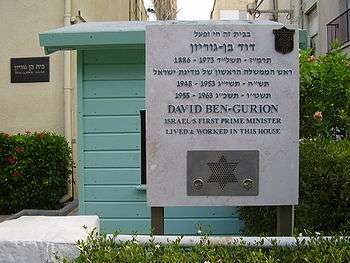Ben-Gurion House
The Ben-Gurion House is an historic house museum in Tel Aviv, in which between 1931 and 1968 served as an additional residence for Israel's first Defense and Prime Minister, David Ben-Gurion, and his family, along with another additional residence, Tzrif Ben-Gurion at the Sde Boker kibbutz in the Negev (known as his desert home), and parallelly with his official residence as Prime Minister of Israel, at Beit Julius Jacobs in Jerusalem. It is located at 17 Ben-Gurion Boulevard,[1] in Tel Aviv.
History and structure
The house was built in 1930–1931, where David Ben-Gurion and his family lived until they settled in Sde-Boker, in 1953, after which they lived only part of each year.[1] It was built on one of the Jewish National Fund's (JNF) property lands, when the first laborer neighborhood was established there at the time.
The house was designed by the Israeli architect David Tuvia, and as customary in laborer neighborhoods in Israel at the time, the house included only one room, and was worth 350 British Mandate Pound (lira eretz-yisra'elit). The house was expanded in 1946, and renovated in 1960.[2]
First floor
The first floor included Renana's room, Ben-Gurion's daughter. It also served Ben-Gurion during the Suez Crisis (Mivtza' Kadesh, "Operation Kadesh") as a shelter and a bedroom. From this room Ben-Gurion conducted his communication with Moshe Dayan, then his Chief of Staff, and from there he had received the updates on the events in the battlefield of the operation.[3]
Second floor
The second floor houses a four-room library. The libraries holds his personal collection of periodicals and 20,000 books, in ancient Greek, Latin, English, Hebrew, French, Turkish, German, Russian and other languages.[1] One of them served as Ben-Gurion's study room, where he had his own study corner, in which he wrote in his diary. It also contained a special phone, that was a direct line to the Defense Ministry's office (compare the Red Phone).
On 13 May 1948, Ben-Gurion hosted the Minhelet ha'am (People's Administration) body: Aharon Zisling, Yehuda Leib Maimon, and Moshe Sharett, where they formulated and drafted the final version of the Israeli Declaration of Independence (Megilat HaAtzma'ut). The next day, they went from this house to Dizengoff House, now known as Independence Hall, and where the Tel Aviv Museum of Art was located at the time, where Ben-Gurion announced on the establishment of the State of Israel.
The libraries that are located at the second floor are known for their unusual size. Ben-Gurion maintained in these libraries more than 20,000 different books, that dealt mainly with the subjects of Zionism, history, various cultures and religions, a diverse collections of Hebrew Bible books and more. By maintaining many books on IDF's fallen soldiers, Ben-Gurion stressed the importance of the subject to him. The books that are written in many languages, may give an idea as to Ben-Gurion's fields of interest.
The second floor also included a toilet and a bedroom, and served only Ben-Gurion himself at the time.
The house nowadays

In his will Ben-Gurion requested to bequest the house to the State of Israel, as is stated:
"I hereby bequeath to the State of Israel my house in Tel Aviv"[4]— Ben-Gurion's will[4]
Three years after Ben-Gurion died, the Ben-Gurion law 1977 was enacted, which stipulates that the house will be open to the public, and will serve as a museum in memory of Ben-Gurion and as a commemoration of his legacy, as well "as a Reading, Reviewing and Research center", as Ben-Gurion himself requested.
The house was opened to the public on 29 November 1974, and as of today, guided tours and symposiums are conducted in the house, with the purpose of depicting Ben-Gurion's character and life work as a leader. In addition, memorabilia, historical documents, and Ben-Gurion's titles awarded to him when he was prime minister are exhibited in the house.
The Boulevard in which the house is situated, was called at the time Ben-Gurion lived there, Keren Kayemet Boulevard ("Jewish National Fund Boulevard"), and was renamed Ben-Gurion Boulevard after Ben-Gurion died. The name Keren Kayemet Boulevard was then moved to a central street within a northern Tel Aviv neighborhood, Ever Ha-Yarkon suburb, and is still named after the JNF today.
See also
- David Ben-Gurion
- Beit Julius Jacobs
- Midreshet Ben-Gurion
- Sde Boker
- Ben-Gurion Boulevard
External links
- Ben-Gurion house official website (in English)
| Wikimedia Commons has media related to Ben-Gurion House. |
Notes
- 1 2 3 https://www.jewishvirtuallibrary.org/jsource/Society_&_Culture/bghouse.html
- ↑ "Ben-Gurion museum in Tel Aviv – David and Paula Ben Gurion’s house in Tel Aviv". Retrieved 29 October 2016.
- ↑ "Beit Ben-Gurion (David Ben-Gurion's House)". Retrieved 29 October 2016.
- 1 2 Ben-Gurion house Archived 14 January 2010 at the Wayback Machine. official website (in English)
Coordinates: 32°05′07″N 34°46′18″E / 32.085329°N 34.771718°E